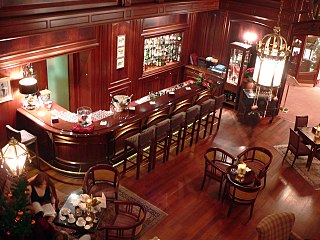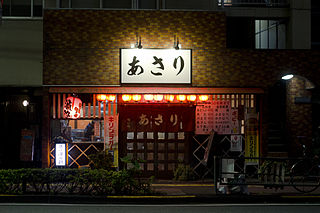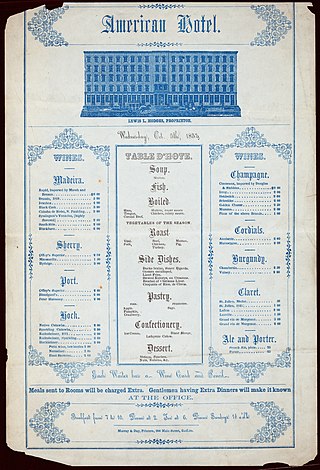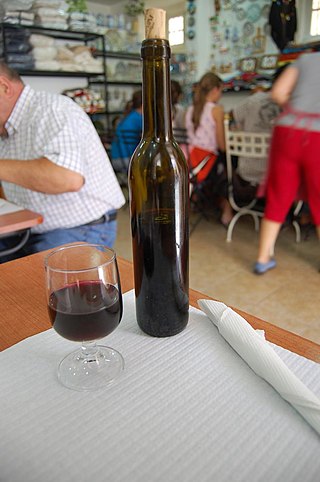
A restaurant is a business that prepares and serves food and drinks to customers. Meals are generally served and eaten on the premises, but many restaurants also offer take-out and food delivery services. Restaurants vary greatly in appearance and offerings, including a wide variety of cuisines and service models ranging from inexpensive fast-food restaurants and cafeterias to mid-priced family restaurants, to high-priced luxury establishments.

A bar, also known as a saloon, a tavern or tippling house, or sometimes as a pub or club, is a retail business establishment that serves alcoholic beverages, such as beer, wine, liquor, cocktails, and other beverages such as mineral water and soft drinks. Bars often also sell snack foods, such as crisps or peanuts, for consumption on their premises. Some types of bars, such as pubs, may also serve food from a restaurant menu. The term "bar" refers to the countertop where drinks are prepared and served, and by extension to the overall premises.

Waiting staff (BrE), waiters / waitresses, or servers (AmE) are those who work at a restaurant, a diner, or a bar and sometimes in private homes, attending to customers by supplying them with food and drink as requested. Waiting staff follow rules and guidelines determined by the manager. Waiting staff carry out many different tasks, such as taking orders, food-running, polishing dishes and silverware, helping bus tables, entertaining patrons, restocking working stations with needed supplies, and handing out the bill.
In a restaurant, the menu is a list of food and beverages offered to customers and the prices. A menu may be à la carte – which presents a list of options from which customers choose – or table d'hôte, in which case a pre-established sequence of courses is offered. Menus may be printed on paper sheets provided to the diners, put on a large poster or display board inside the establishment, displayed outside the restaurant, or put on a digital screen. Since the late 1990s, some restaurants have put their menus online.

An izakaya is a type of informal Japanese bar that serves alcoholic drinks and snacks. Izakaya are casual places for after-work drinking, similar to a pub, a Spanish tapas bar, or an American saloon or tavern.

A sommelier, or wine steward, is a trained and knowledgeable wine professional, normally working in fine restaurants, who specializes in all aspects of wine service as well as wine and food pairing. The role of the sommelier in fine dining today is much more specialized and informed than that of a wine waiter. Sommeliers Australia states that the role is strategically on par with that of the chef de cuisine.
BYOB or BYO is an initialism and acronym concerning alcohol or marijuana that means "bring your own bottle" or "bring your own booze", "bring your own beer", or for marijuana, "bring your own bud".

In restaurant terminology, a table d'hôte menu is a menu where multi-course meals with only a few choices are charged at a fixed total price. Such a menu may be called prix fixe. The terms set meal and set menu are also used.
Wine accessories are things that may be used in the storage or serving of wine. Wine accessories include many items such as wine glasses, corkscrews, and wine racks.

A cover charge is an entrance fee sometimes charged at bars, nightclubs, or restaurants. The American Heritage Dictionary defines it as a "fixed amount added to the bill at a nightclub or restaurant for entertainment or service." In restaurants, cover charges generally do not include the cost of food that is specifically ordered, but in some establishments, they do include the cost of bread, butter, olives and other accompaniments which are provided as a matter of course.
A clip joint or fleshpot is an establishment, usually a strip club or night club, in which customers are tricked into paying far above market prices for low-grade goods or services—or sometimes, nothing—in return. Typically, clip joints suggest the possibility of sex, charge inflated prices for watered-down alcoholic drinks, and then throw out customers when they become unwilling or unable to spend more money. The products and services offered may be illegal, allowing the establishment to maintain the scam with little fear of punishment from law enforcement, since its victims cannot report the venue without admitting that they broke the law. Even when victims have broken no laws, they may be too embarrassed to seek legal recourse.
The Washington State Liquor and Cannabis Board, formerly the Washington State Liquor Control Board, is an administrative agency of the State of Washington. The Liquor and Cannabis Board is part of the executive branch and reports to the Governor. The board's primary function is the licensing of on and off premises establishments which sell any type of alcohol, and the enforcement and education of the state's alcohol, tobacco, and cannabis laws.
Seasons 52 is an American fresh grill and wine bar developed in 2003. The brand concept is to deliver a casually sophisticated atmosphere, seasonal menu, and offer fresh ingredients to deliver menu items that are naturally lighter. As of 2016, there are 42 Seasons 52 locations in the United States.
Restaurants fall into several industry classifications, based upon menu style, preparation methods and pricing, as well as the means by which the food is served to the customer. This article mainly describes the situation in the US, while categorisation differs widely around the world.

A tasting room is a part of a winery or brewery, typically located on the premises of the winery or brewery's production facilities, at which guests may sample the winery or brewery's products. Originally an informal public relations outreach effort of wineries and breweries to encourage visitors and build brand awareness and loyalty by dispensing free wine, beer, whiskey, sake, etc., tasting rooms have increasingly become sophisticated profit centers of winery operations, earning money by charging tasting fees, selling products directly to consumers, signing new members to the winery or brewery's members club, hosting weddings and other public and private events, and selling various wine, beer, whiskey, sake, etc. gift-related goods.

A well drink or rail drink is an alcoholic beverage or mixed drink made using the lower-cost liquors stored within easy reach of the bartender in the bar's "speed rail", "speed rack", or "well", a rack or shelf at a lower level than the bar that the bartender uses to prepare drinks. In any given establishment, the rail/well liquors available may also be known as the "house pours", "house brands", "house spirits", "pour brands", or "proprietary spirits".

Oceanique is a fine dining gourmet French-American cuisine restaurant in Evanston, Illinois that serves seafood. Oceanique has consistently been ranked as the number one seafood restaurant in the Chicago metro area by the Zagat Guide. "Make It Better Magazine" deemed it the best fine dining restaurant in 2014 and awarded them with the "Best of the North Shore" prize. It opened in 1989 and has been in business for 25 years. Mark Grosz is the head chef as well as the owner of the establishment. It is located at 505 Main Street, two blocks from the Main St. 'L' Station. Oceanique has an adjoining outdoor patio that customers can use, weather permitting.
A16 is an Italian restaurant in California. There are two locations: the original location in San Francisco and a second location in Oakland. The restaurant's cuisine focuses on the Italian region of Campania. In 2014, the restaurant was named to the Top 100 Restaurants in San Francisco list by Michael Bauer of the San Francisco Chronicle.

A Greek restaurant is a restaurant that specializes in Greek cuisine. In the United States they tend to be a different affair, varying in types of service, cuisine, menu offerings, table settings, and seating arrangements. Their menu may also feature dishes from other cuisines.

House wine generally refers to an inexpensive drinking wine served in restaurants. Restaurant menus often omit detailed descriptions of a house wine's country of origin, winery or grape varietal, listing it simply as "house red" or "house white", depending on the wine's style. Some restaurants offer more specific categories of house wines, such as a "house chardonnay", or a "house merlot".













